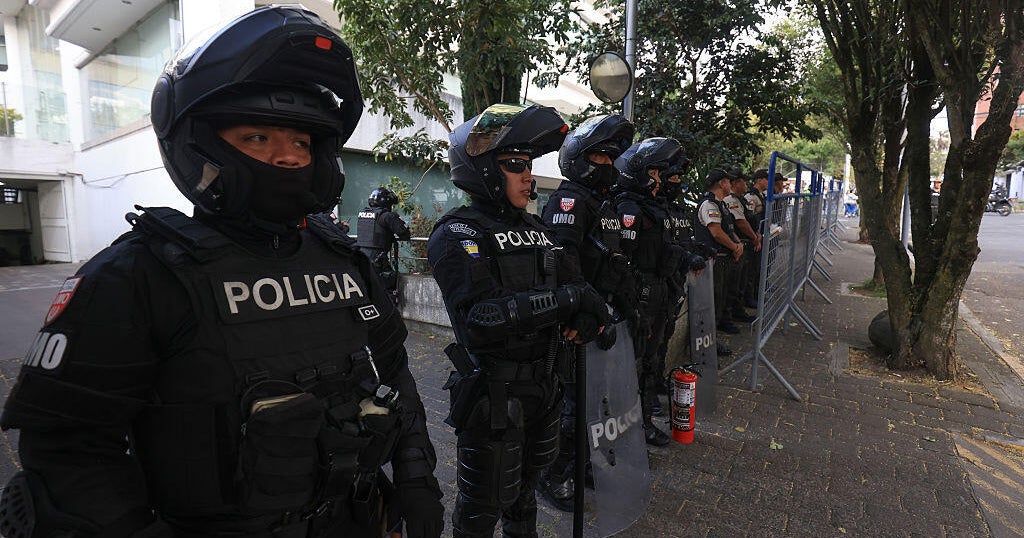Taps gushing with brown water – or reduced to a mere trickle. In recent weeks, Telegram groups from cities across the Donetsk region have been flooded with footage exposing critical water conditions.
In 2014, the city of Donetsk and much of the region around it came under the control of Russian-backed separatists, who declared the creation of the Donetsk People’s Republic. Following Russia’s full-scale invasion of Ukraine in February 2022, Russia formally annexed the entire region, though it has not been recognised internationally.
“The water situation remains unchanged…. Many people still have rusty, cloudy water or poor water pressure,” reads a July 29 post from the "Mariupol Now" Telegram group. The channel was created by a Ukrainian volunteer to share information from this city located in the south of the Donetsk region.
To display this content from Telegram, you must enable advertisement tracking and audience measurement.
Other footage shared on local groups shows residents waiting in line, carrying water containers. A Telegram post from a Donetsk city group chat on July 23 shows a photograph of residents standing in the street with containers, and the caption: “Queue for water on Biryuzova Street”.
To display this content from Telegram, you must enable advertisement tracking and audience measurement.
Residents have been grappling with a severe water crisis for several weeks, with summer heat exacerbating water supply problems that date back to the 2014 takeover.
On July 21, Voda Donbassa, which oversees water supply in the Donetsk region, introduced a strict water schedule for several major cities. For instance, in the city of Donetsk, residents receive water for just four hours every three days, from 5pm to 9pm.
On July 23, residents of the Donetsk Republic sent an open letter to Russian President Vladimir Putin, protesting the "disgusting" quality of their water supply, a "critical and unacceptable" water schedule, and “unfair” water rates. "We have been deprived of the most basic thing – the right to access water," they wrote.
In a video posted on the Telegram channel Obereg Zhizni on July 27, several children also make a direct plea to Putin. "Uncle President – give us the simplest miracle – water in our homes," one child says in the video.
‘Water does not reach the upper floors’
Our Observer, whose identity we are concealing for her safety, is living in Mariupol. She told our team:
“My water supply was damaged during the fighting, and now there is practically no water, just a trickle. We get about 30-40 liters per day. [Editor’s note: The average French person uses about 150 litres of water per day.]
Particularly acute water problems began on July 22, when the water supply schedule was introduced. Water in Mariupol is supplied on a schedule, once every two days, for several hours at a time. The water supply to the private sector has not been cut off, but the pressure is weak. Residents of high-rise buildings feel this problem more acutely; on days when water is supplied according to the schedule, it does not reach the upper floors. Many have been without water for two weeks, since it started being supplied on a schedule.”
‘Today I am doing laundry and washing my hair. I will wash the dishes tomorrow’
In the face of the situation, residents have no choice but to adapt. Our Observer told us:
“The difficulties caused by the water shortage are significant, and we have to plan our water consumption for each day. For example, today I am doing laundry and washing my hair. I will wash the dishes tomorrow. When I do laundry, I have to stand next to the machine and pour water into the detergent compartment by hand. There is nothing to water the garden with, and there is a drought outside.
We learned to cope without a reliable water supply during the war, when there was no water at all and we had to transport it from wells using wheelbarrows and bicycles. We conserve water.
The authorities organise water delivery on a schedule. But this is not convenient at all. People work. And the elderly have to carry water to the upper floors. I, for example, cannot carry heavy loads.”
Images circulating on Telegram show the strategies residents are taking to cope with the shortages. A video shared on a local group on July 17 shows a bucket hung from a window to collect water. “This is Donetsk, baby. We survive however we can,” the woman in the video says, while the caption reads, "Donetsk life hack".
To display this content from Telegram, you must enable advertisement tracking and audience measurement.
Another video shows an individual collecting water from a puddle in the street.
To display this content from Telegram, you must enable advertisement tracking and audience measurement.
‘Humanitarian catastrophe’
The US-based Institute for the Study of War (ISW) reported on July 23 that a “Russian-created water crisis” is creating “unsanitary living conditions in several areas of occupied Ukraine.”
Karolina Hird, Russia team deputy lead at the ISW, told our team:
“Vast areas of occupied Ukraine are facing a borderline catastrophic water shortage. Yenakiyeve, for example, receives a few hours of water supply every four days, which means that people have to stockpile water to do basic life functions.
Water shortages are being compounded by a really high heat wave in occupied Ukraine right now. People need to hydrate themselves when it's hot outside. All of these combined factors are really forcing a humanitarian catastrophe. People are now resorting to drinking from puddles and rainwater and are unable to flush their toilets or properly wash their bodies.
The school year is starting in about a month, which means that there'll be influxes of kids going into classrooms. They need water.”
‘A few trucks with a few tanks of water aren't really going to solve the problem’
The Russia-backed local authorities have been blaming Ukraine for the situation.
“Unfortunately, due to the Ukrainian water blockade, we have to live in such realities for now,” the Kremlin-installed head of the Donetsk People’s Republic, Denis Pushilin, said on June 24, answering questions from residents. He also claimed solving the problem required “liberating” the city of Slavyansk, in the north of the region.
A recent report from the Atlantic Council’s Digital Forensic Research Lab and OpenMinds also found that pro-Russian bot networks are focusing on water issues to foster gratitude towards Russia and undermine Ukraine. The report reveals that these bots published nearly 10,000 posts about the restoration of water supplies between January 2024 and April 2025.
Simultaneously, Russia has communicated extensively about the actions it was taking to manage the situation. “More than 60 water tankers from the sponsoring regions will arrive in the DPR” and “75 tankers from Moscow … have already arrived in the Republic,” Pushilin wrote on a Telegram message on July 27.
But Hird is skeptical about the effects of the measure:
“Given the scale and the severity of the problem, a few trucks with a few tanks of water aren't really going to solve the problem.
We've also been hearing from Ukrainian sources that Russian soldiers, occupation officials, and collaborators are privileged in receiving water first. So sometimes, the Russian occupation officials are the ones who are actually reaping the benefit of this water.”
On August 4, after a meeting with Putin, Pushilin announced that the water bills will be reduced “to the minimum possible level” and the fee for water sewage disposal will be “completely cancelled”.
“This is good news,” our Observer told our team, adding that “water rates have risen sharply since July”.
This, however, “does not address the origin of water supply issues”, the ISW stated in an update.
‘Russian-created crisis’
The think tank argues the current water crisis was “Russian-created”.
Hird notes water shortages in occupied Ukraine have been a persistent problem since 2014, and adds that the current crisis is partly a consequence of years of mismanagement by Russia:
“First and foremost, Russia should have diversified its water supply once it illegally invaded Ukraine. It should have started building out water infrastructure from mainland Russia to make sure that there wasn't a single choke point for water supply to the occupied Donetsk.
There have also been frequent instances of corruption cases in projects to build canals and water pipelines in occupied Ukraine.
And then, Russia has continued to add water consumers to a very strained water system. This was really clear in Crimea in 2018 when Russia basically flooded the peninsula with Russian military personnel, all of their families, and then brought in tourists.”
Vital canal destroyed
But the war has exacerbated existing pressures, further disrupting the water supply by destroying pipelines, dams and pumping stations.
Among the affected infrastructure is the Siverskyi Donets-Donbas canal, a primary water source for the entire region, constructed in the 1950s. This canal runs from the northeastern corner of Donetsk Oblast to the city of Donetsk, continuing south to the occupied port city of Mariupol.
Hird explains:
“The canal has been in danger since 2014. There's been sporadic shelling of the canal in the areas close to the 2014 frontline since the first invasion of Ukraine.
But at this point, it's unusable. As combat operations have intensified around Chasiv Yar, the canal has become a frontline formation. Russian forces were using the canal up until recently for military purposes: to move troops and equipment and hide infantry from Ukrainian drone and artillery strikes.
It is inevitable that Ukrainian forces have struck the canal, but they were basically forced to strike the canal by Russian forces using civilian water infrastructure for military purposes, which was necessitated by the Russian invasion of Ukraine in the first place.
When you look at international law, it all boils down to the fact that Russia illegally invaded Ukraine. Russia should never have invaded and occupied Ukraine in the first place. But since it did, it has responsibilities to the population it is occupying, and it is not fulfilling those responsibilities. Its military actions and its use of civilian water infrastructure are illegal violations of the responsibilities that Russia has as an occupying power.”
To address the crisis, Russia launched the construction of a nearly 200-kilometre water pipeline designed to transport water from Russia's region of Rostov-on-Don.
However, though inaugurated in 2023, the Don-Donbas pipeline has already sustained partial damage and is proving insufficient to meet the region's water demands. Pushilin said on July 22 that it was providing “only 25-30 percent” of their needs.
Reservoirs drying out
Pushilin also stated, “the situation with internal reservoirs is close to critical.”
These reservoirs, located around Donetsk, have been contributing to the city's water supply. But they were themselves supplied by the now-destroyed Siverskyi Donets-Donbas Canal, and are now also drying up because of the intense heat.
For instance, satellite imagery reveals a significant decrease in the water level of the Khanzhenkivs'ke Reservoir – situated about 20 kilometres northeast of Donetsk - since 2022.
To display this content from , you must enable advertisement tracking and audience measurement.
A BBC Russia analysis of 10 water reservoirs near Donetsk revealed that nine of them have noticeably become shallower since Russia began its full-scale invasion of Ukraine in 2022.
Besides health impacts, Hird also points to broader, more long-term consequences:
“There are power plants, both hydroelectric and thermal, throughout occupied Ukraine that rely on a water supply for electricity generation. That is going to be a really big issue, in terms of cooling people's homes in the summer, but also in terms of heating when the weather gets colder.
We're seeing a bunch of dominoes starting to fall that are going to break the public goods infrastructure in occupied Ukraine and deepen the humanitarian crisis in weeks and months to come.”










 English (US) ·
English (US) ·